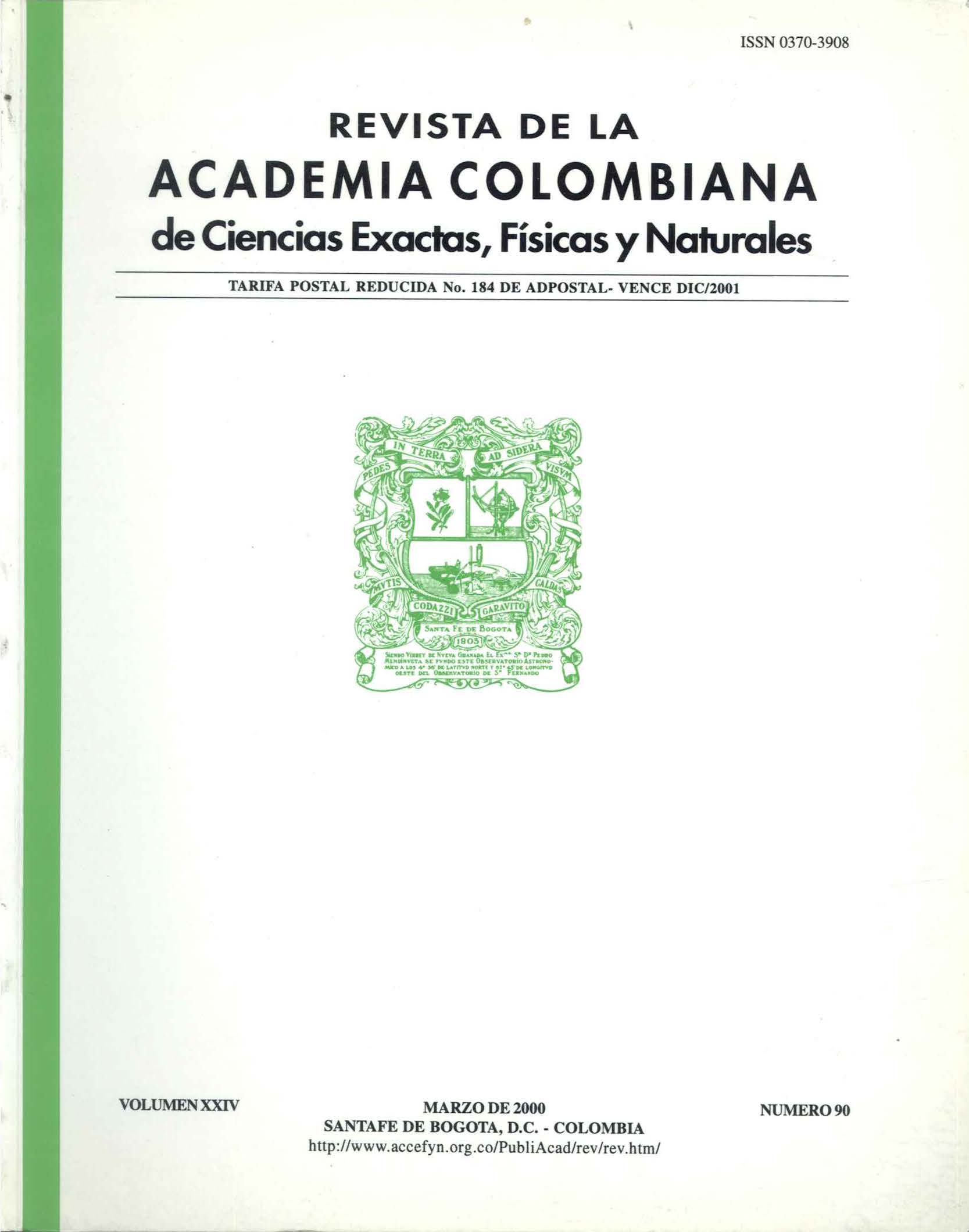Resumen
Entre noviembre de 1996 y septiembre de 1997 se visitó mensualmente un cuerpo de agua artificial en la región de Anchicayá, Pacifico colombiano, con el objetivo de registrar aspectos ecológicos en una población de la rana arbórea Agalychnis spurrelli: tamaño corporal de los individuos, picos reproductivos, territorialidad, comportamiento de amplexus y oviposición, selección de sitio de postura, características de las nidadas y predación. Otras once especies de anuros fueron registradas alrededor de este cuerpo de agua, de ellas, Smilisca phaeota e Hyla rosenbergi también exhibieron actividad de reproducción, pero debido a diferencias en el sitio de canto, tipo de canto y lugar de oviposición, no compiten con A. spurrelli, logrando así, una división del recurso acuático.
Referencias
Bagnara, J. T., L. lela, F. Morrisett & R. K. Rastogi 1986. Reproduction in the mexican leaf frog (Puchymedusa dacnicvlor). Behavior and morphological aspects. Occ. Pap. Mus. of Nat. Hist. Univ. of Kansas, 121: 1 · 31.
Bolaños, M. E. & S. F. Vargas. 1996. Patrone s de coloración de la rana arbórea Agalychnü spurrelli (Boulenger) y su posible uso como técnica de marcaje para el monitoreo de individuos. En: Estela, F. & Sedano R. E. (Edt). Mem IV Simp. Biología y I Simp. Nac. de Biología Univ. del Valle. pp. 39-44.
Caldwell, J. P. 1994. Natural history and survival of eggs and early Larval stages of Agalychnis calcarifer (Anura Hylidae) . Herpetological Natural History. 2(2): 57 - 66.
Cochran, D.M. & C. J. Goin. 1970. Frogs of Colombia. Bull. U.S. Nat. Mus., 288: 1-655.
Duellman, E. W. 1970. The Hylid Frogs of Middle America. Monographs of the Mus. Nat. Hist. Univ. Kansas, 1-2: l-753pp.
Duellman, E. W. 1978. The biology of an Equatorial Herpetofauna in Amazonian Ecuador. The University of Kansas Publications, Museum of Natural History. 1-352 pp.
Duellman, E. W. & L.Trueb. 1986. Biology of amphibians. McGraw Hill. Inc.
Espinal, T. S. & E. Montenegro. 1963. Formaciones vegetales de Colombia. Memoria explicativa sobre el mapa de Colombia. IGAC Bogotá O.E.
Frost, D. R. (Ed.). 1985. Amphibiam species of the world. A taxonomic and geographical reference. Allen Press, Inc. & The Association of Systematics Collections Lawrence, Kansas, U.S.A.: 732 pp.
Harris, L. D. 1988. Edge effects and conservation of biotic diversity. Conservation Biology, 2:330 -332.
Heyer, W. R., R. W. McDiarmid & D. L. Weigmann. 1975. Tadpoles, predation and pond habitats in the tropics. Biotrópica 7: 100 - 111.
Heyer, W. R., M Donnelly., R. W. McDiarmid, L. Hayek & M. Foster. (Edt). 1994. Meausiring and monitoring · biological diversity. Standart methods for Amphibiams. Smithsonians Inst. Press., 1-364pp.
Hoogmoed, M.S. & J. E. Cadle. 1991. Natural history and distribution of Agalychnis craspedopus (Funkhouser 1957) (Amphibia Anura Hylidae). Zool. Mededelingen, 65: 129 - 142.
Kattan, G. H. & H. Alvarez-López. 1996. Preservation and management of biodiversity in fragmented landscapes in the Colombian Andes. In: J. Shelhas and R. Greenberg (Edt). Forest patches in Tropical Landscapes. Island press. pp 3-18.
Kluge, A. G. 1981. The life history, social organization, and parental behavior of Hyla rosenbergi Boulenger, a nest-building gladiator frog. Mise. Publ. Mus. Zool. Univ. Michigan. 160:1-170.
Marquis, R. J., M. A. Donnelly & C. Guyer. 1986. Aggregations of calling males of Agalychnis calcarifer Boulenger (Anura Hylidae) in a Costa Rican Lowland wet forest. Biotrópica, 18(2): 173-175.
Pérez, F. M. 1996. Avalancha en vía al mar. Periódico El País, Cali 6 de mayo de 1996.
Pybum, W. F. 1970. Breeding behavior of the leaf-frogs Phyllomedusa callydras and Phyllomedusa dacnicolor in México. Copeia, 2: 209 - 218.
Pybum, W. F. 1980. The function of eggless capsules and leaf in nest of the frog Phyllomedusa hypochondrialis (Anura Hylidae). Proc. Biol. Soc. Wash. 93(1): 153 - 167.
Pybum, W. F.& J. R. Glidewell. 1971. Nest and breeding behavior of Phyllomedusa hypochondrialis in Colombia. Jour. Herp. 5: 49 - 52.
Ruiz-C. P. M., M. C. Ardila-R. & J. D. Lynch. 1996. Lista actualizada de la fauna de Amphibia de Colombia. Rev. Acad. Colomb. Cienc. 20(77): 65-415.
Semlitsch, R. D. & W, J. Gibbons. 1988. Fish predation in size structured population of treefrog tadpodles. Oecología 75: 321 - 326.
Scott, N. J. & A. Starret. 1974. An unnusual breeding aggregation of frogs, with notes on the ecology of Agalychnis spurrelli (Anura Hylidae). Bull. of Southern California Academy of Sciences 73(2): 86 - 94.
Vargas, S. F. & F. Castro. 1999. Distribución y preferencias de microhábitat en anuros (Amphibia) en bosque maduro y áreas perturbadas en una zona de Anchicayá, Pacífico colombiano. Caldasia. 21(1): 95-109.
Vargas, S. F. & M. E. Bolaños. 1999a. Contribución al conocimiento de los reptiles presentes en la región de Anchicayá a través de un gradiente de deforestación. Caldasia. 21(2): 235-238.
Vargas, S. F. & M. E. Bolaños 1999b. Estructura y composición de una comunidad de anfibios y reptiles presentes en hábitats perturbados de selva lluviosa tropical en el Bajo Anchicayá, Pacífico Colombiano. Informe de investigación Fundación Herencia Verde Cali Colombia. 47 pp.
Yahner, H. R. 1988. Changes in wildlife communites near edges. Conservation Biology 2: 333 - 339.

Esta obra está bajo una licencia internacional Creative Commons Atribución-NoComercial-SinDerivadas 4.0.
Derechos de autor 2024 Revista de la Academia Colombiana de Ciencias Exactas, Físicas y Naturales

